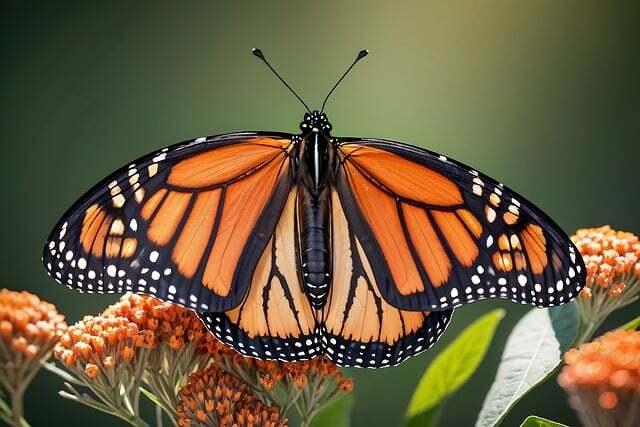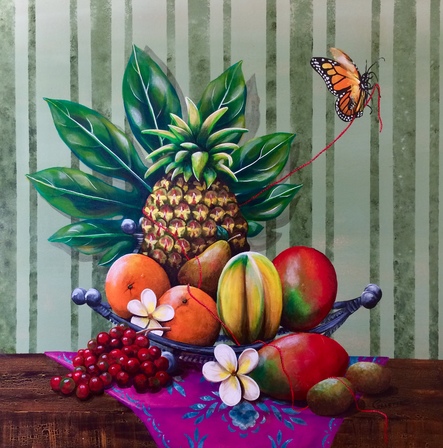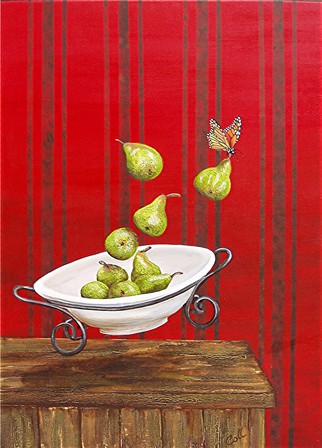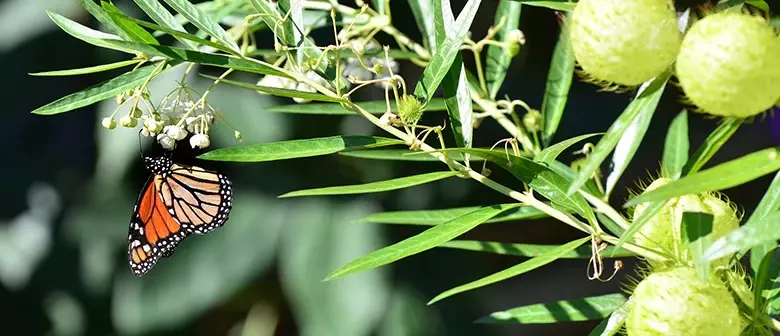Monarch Butterflies: A Symphony of Nature's Beauty
Monarch butterflies, a recurring theme in my New Zealand artwork, like the main image Tropical Fruit Salad, as they hold a unique allure. Their natural beauty, surpassing even the vibrant species housed in Dunedin's Butterfly House in New Zealand, is a testament to the wonders of nature.
While many butterflies dazzle with their vivid colours, the Monarch, with its humble yet striking appearance, holds a special place in my heart. This sentiment is likely shared by many New Zealanders who grew up with swan plants in their gardens, witnessing the captivating life cycle of these incredible creatures.
From plump yellow and black striped caterpillars to the exquisite green chrysalis adorned with delicate hints of gold, they undergo a rapid transformation before emerging as the stunning butterfly with its black, orange and white spotted wings, adding to their allure and fascination.
Monarch Butterfly
What do we know about the Monarch butterfly? Originating from North America, Monarchs were discovered in New Zealand in the early 19th century. They are also found in the Canary Islands, the Azores, Madeira, and occasionally in Western Europe. Monarchs typically live for about four to six weeks, with some individuals living up to eight months.
The Monarch's wings feature a distinctive orange and black pattern, with an 8.9–10.2 centimetres wingspan. Notably, female Monarchs have darker veins on their wings, while males have a prominent black spot in the centre of each lower wing, where pheromones are released.
Males also exhibit straight-edged wings, whereas females' wings have a graceful curve.

The upper side of the wings for both sexes displays a darker orange with black veins and margins, adorned with two series of small white spots. The forewings also have a few orange spots near the tip. The underside is similar but transitions to a yellow-brown at the tips, with more prominent white spots.
Despite having six legs, like all insects, Monarchs use only four for movement, holding their two front legs against their bodies.
Monarch Eggs and Caterpillars
Monarch eggs, creamy white at first, gradually turn pale yellow. These conical eggs, about 1.2 millimetres high and 0.9 millimetres wide, are intricately designed with approximately 23 ridges and numerous fine crosswise lines, resembling tiny upside-down pots. They are usually laid on the underside of swan plant leaves.
The Monarch caterpillar is a marvel in its own right, adorned with striking yellow, black, and white stripes. Its head is also striped and features two pairs of black filaments, one pair at each end of its body, often giving the illusion of being two-headed.
The caterpillar can grow up to 5 centimetres in length. However, they are not without their predators. Birds, spiders, wasps, and other insects all pose a threat to these caterpillars, making their survival a remarkable feat.
The Chrysalis: Nature's Jewel
My favourite stage of the Monarch's life cycle is the chrysalis, a stunning pale lime green similar to the exquisite Japanese jade, with a band of black and gold at the end of the abdomen.
Additional gold spots decorate the thorax, wing bases, and what are known as the eyes. Inside this chrysalis, a remarkable transformation is taking place. The caterpillar's body is breaking down and reorganizing into a completely new form. This process, known as metamorphosis, is one of nature's most incredible feats.
Attracting Monarchs: Creating a Butterfly Garden
Many people attract Monarchs by cultivating butterfly gardens with swan plants, a specific milkweed species. Milkweed is crucial to the Monarch's life cycle as it is the only plant on which they lay their eggs and the sole food source for their caterpillars.
These gardens offer a wonderful opportunity to teach children about the butterfly life cycle, as they can watch the transformation from egg to caterpillar to chrysalis to butterfly.
Managing the number of caterpillars on your swan plant is crucial, but it doesn't have to be daunting. Even large plants can be stripped of their foliage, leading to the plant's demise. However, there are practical solutions. You can protect a portion of the foliage by covering it with a small clear plastic bag and securing it to ensure no caterpillars can access the leaves inside.
Puncture tiny holes in the bag for ventilation and moisture control. This method allows the plant to survive and regenerate for the next season. Once the caterpillars have finished for the season, remove the bag to give the plant a chance to thrive. With these simple steps, you can enjoy the beauty of Monarchs in your garden without compromising the health of your plants.
Monarch butterflies, with their intricate beauty and fascinating life cycle, continue to inspire awe and admiration. They also play a crucial role in our ecosystem as pollinators, helping to fertilise plants and ensure their survival. Symbolising the delicate balance of nature and the importance of conservation,
Monarchs are not just a symbol in my artArtworks but in the hearts of all who observe them.
Posted: Monday 7 June 2010



